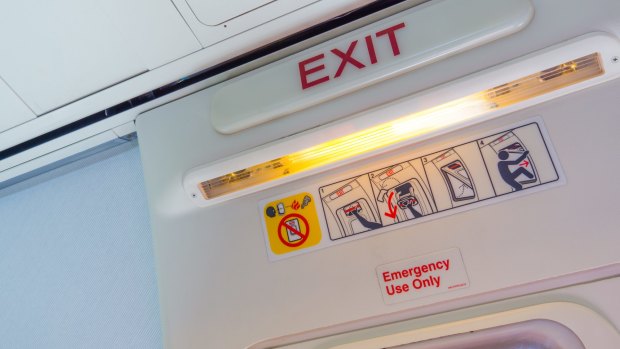This was published 6 years ago
Why do some aircraft emergency exit doors have red tape over the window?

Aircraft doors have many safety measures attached. Credit: Adobe Stock
At the start of every flight, after the doors are closed and as the aircraft starts to push back from the terminal, you'll hear the announcement "Cabin crew arm doors and cross check." Cabin crew stationed at emergency exits throughout the cabin will then activate the emergency slide by pushing a lever on the door.
They might also position a strip of red or orange tape diagonally across the window above the emergency slide. The door is now armed, which means if it's opened the emergency slide will deploy and inflate. This happens with explosive force. It is a requirement that an aircraft emergency slide must fully inflate in just six seconds.
The tape across the window signifies to anyone approaching the aircraft from outside – perhaps a firefighter in an emergency situation – that the door is armed, and to stay clear. Some aircraft types have other ways of indicating an armed door, but every aircraft has some method of warning those outside when a door is armed.
How hard is it to open an aircraft emergency door?
An emergency over-wing exit door weighs up to 18 kilograms, which is why airlines restrict emergency row seating to those passengers ready, willing and able to operate and remove the door.
After the door is opened it should be tossed out on to the wing, not stowed inside the aircraft where it might impede evacuating passengers. Some escape doors are slightly larger than the aperture to facilitate sealing inside the pressurised cabin. These doors must be twisted to the diagonal before they can be tossed out.
Modern aircraft, such as the Boeing 737 Next Generation, sometimes have an emergency door hinged at the top, making it much easier to open. Emergency exit design and procedures were extensively modified after the Manchester air disaster of 1985 when a Boeing 737 caught fire during take-off, with the loss of 38 lives.
The passenger seated at the right over-wing exit had difficulty operating the emergency hatch, and at that time there was no requirement to brief exit-row passengers on emergency procedures. After the door was opened it fell inward, trapping the passenger seated next to it. Even with the door open, passengers had difficulty evacuating since the seating in the exit row allowed only 27 centimetres for passengers to pass between the seat back and the seat cushions. The exit was positioned over a seat, making evacuation even more difficult. Most of those who lost their lives were found near the emergency exit.
See also: Is your life jacket actually there? The truth about emergencies on planes
Sign up for the Traveller newsletter
The latest travel news, tips and inspiration delivered to your inbox. Sign up now.